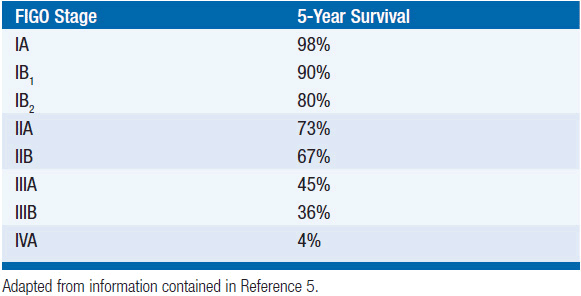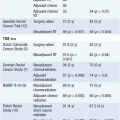Primary Squamous Carcinoma of the Uterine Cervix: Diagnosis and Management
Olivia Foley, Marcela G. del Carmen
INTRODUCTION
Squamous cell carcinoma of the uterine cervix comprises an estimated 80% of all cervical cancers. The other histologies include adenocarcinoma (15%) and adenosquamous carcinomas (3%–5%), with only a small fraction of all cervical cancers having neuroendocrine or small cell histology. This chapter will focus on the diagnosis and management of primary squamous cell carcinoma of the uterine cervix. Amongst all malignancies, cervical cancer is the second most common cancer affecting women, with an estimated 52% case-fatality rate (1). Worldwide, cervical cancer is the most common gynecologic malignancy, accounting for 529,800 new cases (9%) and 273,200 deaths (8%) (1, 2). In developed countries, cervical cancer ranked tenth most common type of cancer in women (9.0/100,000 women) and below the top 10 causes of cancer mortality (3.2/100,000 deaths) (3). An estimated 86% of new cervical cancer cases are seen in the developing world, ranking as the second most common type of cancer (17.8/100,000 women) and cause of cancer deaths (99.8/100,000 deaths) (3). The highest incidence rates worldwide are observed in sub-Saharan Africa, Latin America and the Caribbean, South-Central Asia, and Southeast Asia (1). One-third of the cervical cancer burden in the world is experienced in South-Central Asia. Lastly, although cervical cytology is an excellent screening instrument for pre-invasive disease, the false negative rate for detecting invasive carcinoma is relatively high, reportedly 50%.
 INCIDENCE
INCIDENCE
The incidence of invasive cervical cancer is related to age, with a mean age at the time of diagnosis of 48 years in the United States (3). The reported age-adjusted incidence of cervical cancer in the United States in girls under 20 years of age is 0.1 per 100,000, 1.5 per 100,000 in women aged 20–24 years, and 11.0 per 100,000 for women aged 30 to over 85 years (3).
 EPIDEMIOLOGY
EPIDEMIOLOGY
Patients with squamous cell carcinoma of the cervix share the same risk factors as patients with cervical intraepithelial neoplasia or dysplasia (4). These factors include:
• Early onset of sexual activity
• Multiple sexual partners
• High-risk sexual partners
• History of sexually transmitted diseases
• Tobacco use
• Multiparity
• Low socioeconomic status
• Immunosuppression
• Previous history of vulvar or vaginal dysplasia
Perhaps the most significant risk factor for developing squamous cell cervical cancer is lack of cervical cytological screening. It is critical to underscore that infection with certain subtypes of the human papillomavirus (HPV) has been identified as the central causative factor in the development of cervical neoplasia (4). High-risk oncogenic types can be detected in almost all cervical cancers (4). Although most HPV infections are transient, chronic persistent HPV infection with the oncogenic subtypes is the central causative factor in the development of cervical neoplasia. The virus alone, however, is not sufficient to cause cervical neoplasia or cancer (4).
CLINICAL MANIFESTATIONS
 SYMPTOMS
SYMPTOMS
Because early cervical cancer is usually asymptomatic, screening is critical. Common symptoms, when they occur, include abnormal vaginal bleeding, bleeding after intercourse, and a vaginal discharge (watery, mucoid, malodorous, or even purulent). In the setting of advanced disease, patients may complain of back pain radiating to the lower extremities or pelvic pain. Other symptoms seen in the setting of advanced disease include bowel and urinary symptoms, such as hematuria, hemotochezia, or stool/urine passage per vagina.
 PHYSICAL EXAMINATION
PHYSICAL EXAMINATION
Findings at the time of physical examination may range from a normal appearing cervix to a grossly abnormal cervix with an exophytic, plaquelike, indurated, ulcerated, or endophytic lesion. Findings encountered in patients with regionally advanced stage disease include parametrial, paracervical, or vaginal involvement, lower extremity edema, and inguinal adenopathy. Distant disease may be manifest in ascites, pleural effusions, and supraclavicular adenopathy.
PATTERNS OF SPREAD
Squamous cell carcinoma of the cervix may spread via direct extension as well as lymphatic and hematogenous dissemination. It can spread directly to the parametria, uterine corpus, vagina, bladder, rectum, and peritoneal cavity. Although prior dictum described a predictable pattern of lymphatic spread, sentinel node mapping has demonstrated that the first site of metastasis may involve any one of the pelvic lymph node chains.
DIAGNOSIS
Squamous cell carcinoma of the uterine cervix is staged clinically based on the criteria delineated by the International Federation of Gynecology and Obstetrics (FIGO). Table 55-1 reflects the staging FIGO changes made in 2009.
TABLE 55-1 STAGING OF CERVICAL CANCER BASED ON CRITERIA FROM THE INTERNATIONAL FEDERATION OF GYNECOLOGY AND OBSTETRICS (FIGO)

 CLINICAL STAGING PROCEDURES
CLINICAL STAGING PROCEDURES
After histological confirmation of an invasive cancer, a thorough physical examination is mandated. This survey should include careful inspection of the cervix, assessment of its size, and careful examination of the entire vagina. Cervical tumor size and parametrial involvement are best evaluated through a rectovaginal examination. The inguinal and supracervical regions should be inspected for the presence of adenopathy. It is reasonable to arrange for an examination under anesthesia in order to better appreciate the extent of local disease and to facilitate patient comfort. The following studies and procedures are allowed by FIGO as part of the staging of cervical cancer:
• Chest x-ray
• Intravenous pyelogram
• Barium enema
• Skeletal x-rays
• Colposcopy/biopsies
• Cervical conization
• Cystoscopy
• Proctoscopy
Other optional studies and procedures that can be obtained, but cannot alter FIGO staging, include the following:
• Computed tomography
• Magnetic resonance imaging
• Positron emission tomography (PET)
• Radionucleotide scanning
• Laparoscopy
• Laparotomy
 PROGNOSIS
PROGNOSIS
Prognosis for squamous cell carcinoma of the uterine cervix is influenced by numerous tumor-related factors, including stage, tumor volume, depth of invasion, lymph node involvement, lymph-vascular space involvement, histologic subtype, and tumor grade. FIGO tumor stage correlates well with 5-year survival (Table 55-2) (5). Lymph nodal status is also an important prognostic factor. Five-year survival in the presence of pelvic lymph node involvement is 45%–60% (6). Five-year survival in the setting of para-aortic lymph node involvement is estimated to be 15%–30% (7). The number of involved lymph nodes also plays a critical role. In the presence of one involved pelvic lymph node, the recurrence risk in 35% (7). When 2 or 3 pelvic lymph nodes are involved, the risk of recurrence is 59% and 69%, respectively (7).
TABLE 55-2 FIVE-YEAR SURVIVAL FOR SQUAMOUS CELL CARCINOMA OF THE UTERINE CERVIX BASED ON FIGO STAGING

Stay updated, free articles. Join our Telegram channel

Full access? Get Clinical Tree






